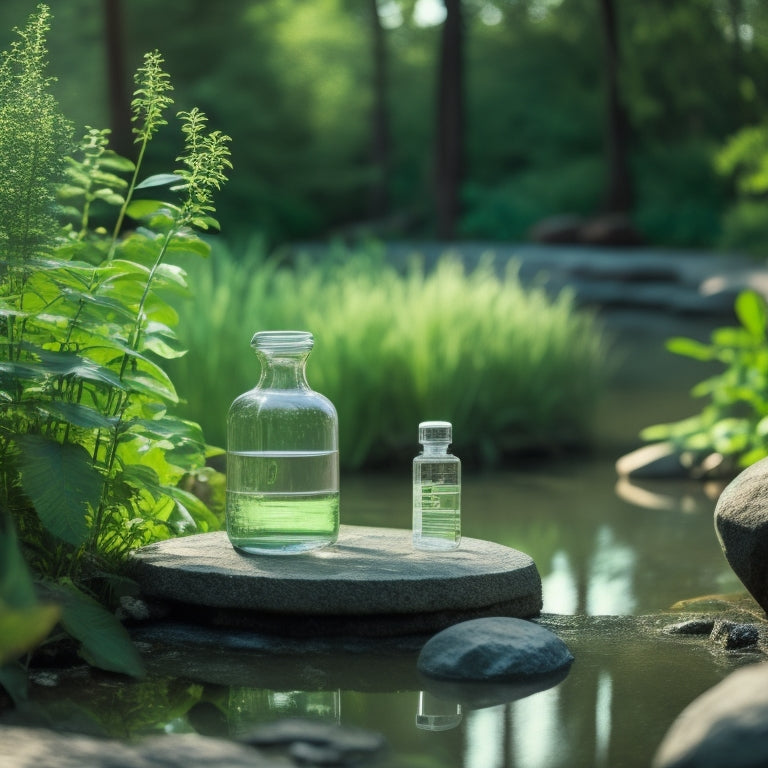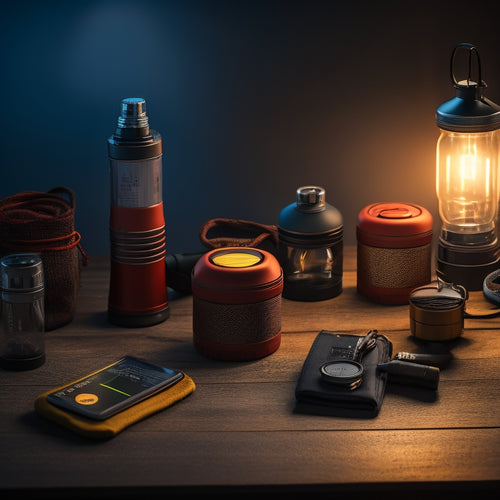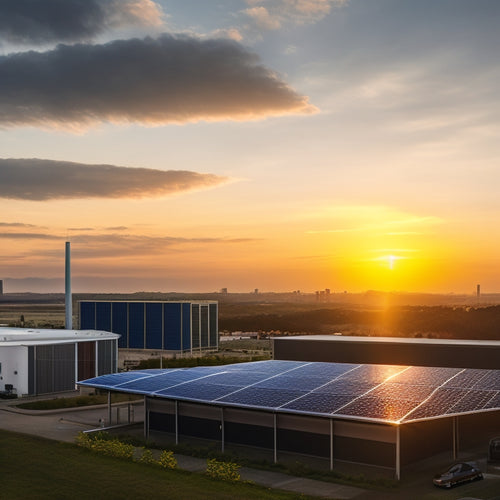
10 Tips for Sun-Powered Water Purification
Share
When it comes to utilizing the power of the sun to purify water, you need an all-encompassing approach that combines effective solar energy capture, suitable purification methods, and efficient water containers to produce clean drinking water reliably. You'll want to optimize your solar panels' angle and orientation, invest in high-efficiency panels, and consider hybrid energy systems. Next, select a purification method like reverse osmosis or UV treatment, and choose containers that withstand UV exposure and resist contamination. By combining these elements and monitoring water quality, you'll be well on your way to producing clean drinking water - and there's still more to investigate to optimize your system's performance.
Overview
- Optimize solar panel angle and orientation seasonally to maximize energy capture for efficient water purification.
- Choose water purification methods based on contaminant analysis, and consider combining methods for comprehensive results.
- Select UV-resistant containers made of materials like borosilicate glass or stainless steel to prevent contamination and degradation.
- Implement UV safety measures, regular maintenance, and energy-efficient appliances to ensure effective and sustainable purification.
- Monitor water quality and safety through regular testing, contaminant monitoring, and corrective actions to ensure safe consumption.
Harnessing Solar Power Effectively
When designing a sun-powered water purification system, your solar panel's energy output is only as good as its ability to capture the sun's rays effectively.
To maximize solar energy efficiency, consider the panel's angle and orientation. Adjust it seasonally to optimize energy capture, as the sun's position changes throughout the year. Real-time monitoring with smart sensors can also help identify potential issues and optimize production.
Additionally, make certain the panel is clean and free of debris, which can reduce energy output by up to 25%. Proper placement of panels minimizes shading from trees and structures, and investing in sustainable technologies, such as high-efficiency solar panels, can also enhance your system's overall performance.
Choosing the Right Purification Method
Efficiency converges with effectiveness when you select the right purification method for your sun-powered water purification system.
You'll want to take into account the type and level of contaminants present in your water source. Chemical treatments can effectively kill bacteria and viruses, but may not remove particulate matter or heavy metals.
Filtration systems, on the other hand, can remove particulate matter, but may not be effective against dissolved contaminants. For instance, reverse osmosis (RO) uses semipermeable membranes to eliminate dissolved solids and microorganisms solar-powered systems.
You may need to combine multiple methods to achieve ideal results. Evaluate factors like maintenance requirements, cost, and the level of purification needed for your specific situation.
Selecting Suitable Water Containers
By virtue of their role in storing purified water, your containers must be able to withstand the rigors of UV exposure and resist contamination.
When selecting a suitable container, consider the material durability and its ability to withstand UV radiation without degrading or leaching chemicals into the water. Avoid using containers made from low-density polyethylene or polypropylene, as they can break down under UV exposure.
Additionally, it's crucial to guarantee energy independence in rural areas, which can be achieved through reliable solar energy for water pumping systems.
Opt for containers made from UV-resistant materials like borosilicate glass, stainless steel, or high-density polyethylene.
Also, consider the container size, as it will impact the purification process. A larger container can purify more water at once, but may be heavier and more difficult to transport.
Choose a size that balances your purification needs with portability and convenience.
Understanding UV Water Purification
Now that you've selected a suitable container, it's time to employ the power of UV light to purify your water. UV radiation effects on microorganisms are lethal, making it an effective method for water treatment.
Additionally, energy-efficient appliances like LED-lit refrigerators can also play an essential role in reducing your boat's overall energy load.
UV germicidal properties inactivate bacteria, viruses, and other pathogens, guaranteeing your water is safe to drink. When choosing a UV water treatment system, consider the UV light sources and their intensity, as well as the system's UV purification efficiency.
Don't forget to implement UV safety measures, such as protective eyewear and skin coverage, when working with UV systems.
Regular UV system maintenance is imperative to guarantee peak performance. Stay updated on UV technology advancements to maximize your system's effectiveness.
Using Thermal Water Purification
Utilizing the power of heat, thermal water purification offers an alternative method to eliminate impurities from your water supply. This process capitalizes on thermal evaporation, where water is heated to produce steam, leaving contaminants behind.
You can utilize solar energy to power this process, making it an energy-efficient and eco-friendly solution, similar to the energy-efficient appliances high-efficiency solar panels used in eco-friendly boat energy systems.
By integrating this method with a hybrid energy system, you can guarantee a reliable source of clean energy to power your purification process. As the steam cools, it condenses into clean drinking water.
Maintaining Your Solar Still
Your solar still is a significant asset in providing clean drinking water, and regular maintenance is key to guaranteeing its ideal performance and longevity.
Develop a maintenance schedule to perform operational checks, cleaning techniques, and material care. Seasonal adjustments may be necessary to optimize efficiency improvements.
Troubleshooting issues promptly can prevent damage and prolong the life of your still. Implement longevity practices by storing it properly when not in use.
Regularly inspect and replace worn-out parts to prevent malfunction. Keep a record of performance monitoring to identify areas for improvement.
Building a Solar Water Distiller
Two essential components make up a solar water distiller: a condenser and a boiler.
You'll need a well-designed solar still to facilitate the evaporation process. The boiler is where the contaminated water is heated, and the condenser is where the water vapor is cooled and collected.
When building your solar water distiller, consider a solar still design that maximizes heat absorption and minimizes heat loss. Make sure your boiler is dark-colored and has good thermal conductivity to enhance the evaporation process.
You can use a glass or plastic container as your condenser, as long as it's clean and free of contaminants. Properly assemble and seal your distiller to prevent any vapor from escaping.
With these components in place, you'll be able to purify water using the power of the sun.
Purifying Water With Solar Ovens
When you're not near a suitable body of water, solar ovens can be a reliable alternative for purifying water. These ovens employ solar energy to heat water, killing bacteria and viruses that can cause illness. Solar ovens are an effective way to purify water without relying on fuel or electricity, making them a great option for off-grid or emergency situations.
| Advantages | Description |
|---|---|
| Renewable Energy | Captures solar energy, reducing environmental impact |
| Portability | Lightweight and compact design for easy transport |
| Low Maintenance | No fuel or electricity required, reducing upkeep |
| Versatility | Can be used for cooking and water purification |
Incorporating Solar Filters and Screens
Since solar ovens may not always be accessible, incorporating solar filters and screens into your water purification routine offers an alternative solution.
You'll find that various solar filter types, such as ceramic, carbon, and UV filters, can remove contaminants and pathogens from water. When selecting a solar filter, consider factors like filter pore size, flow rate, and maintenance requirements.
Additionally, screens made from materials like nylon, polyester, or stainless steel can be used to pre-filter larger particles from the water before it passes through the solar filter.
Monitoring Water Quality and Safety
Each liter of purified water you produce is only as good as the quality control measures you have in place. You must regularly test your water to verify it's safe for consumption.
Conducting routine water testing helps you identify potential contamination sources and take corrective action. Check for pH levels, turbidity, and bacterial presence using affordable and easy-to-use testing kits.
You should also inspect your equipment and pipes for signs of corrosion or damage, which can lead to contamination. Implement a maintenance schedule to clean and replace filters, and perform system checks to prevent failures.
Frequently Asked Questions
Can I Use Solar Power to Purify Seawater or Brackish Water?
You can utilize solar power to purify seawater or brackish water through effective seawater filtration methods, such as solar stills or membrane distillation, which remove salt and contaminants, making them safe for drinking and other uses.
How Do I Clean and Maintain My Solar Still's Reflective Surface?
Shine on, innovator! To keep your solar still's reflective surface sparkling, you'll need to excel in gentle cleaning techniques, carefully selecting surface materials that can withstand the elements, and regularly dusting off debris to guarantee peak performance.
Are There Any Portable Solar Water Purification Systems Available?
You'll find portable options integrating solar technology, like water bottles and backpacks, that employ UV light or thermal energy to purify water, offering freedom from contaminated sources and reliable access to clean drinking water anywhere.
Can I Use Solar Power to Purify Water for Irrigation Purposes?
You're probably thinking, 'Why not just use the sun to grow your crops instead of purifying water for irrigation?' But, surprisingly, you can utilize solar energy to power UV water treatment systems, making it possible to efficiently implement advanced irrigation techniques.
Do Solar Water Purification Systems Work on Cloudy or Rainy Days?
You'll find that solar water purification systems' efficiency varies on cloudy or rainy days due to cloud coverage effects, so you'll need to take into account these solar efficiency variations when designing your system for ideal performance.
Ready to Buy
As you utilize the sun's energy, you'll reveal a world of possibilities: UV rays purifying water with precision, thermal power heating it to perfection, and solar ovens cooking it to safety. You'll craft a distiller that separates the pure from the impure, and filters that sieve out the unwanted. With each method, you'll weave a fabric of cleanliness, where every thread is a symbol of the sun's power and your ingenuity.
Related Posts
-

Best Solar Powered Flashlights for Emergency Situations
When you're choosing the best solar-powered flashlights for emergency situations, focus on their brightness, battery ...
-

Solar Powered Lights for Sustainable Home Decor
Solar-powered lights offer a stylish and eco-friendly way to enhance your home decor. They capture sunlight, converti...
-

Advantages of Commercial Solar Battery On-Site Storage
By investing in a commercial solar battery on-site storage system, you can greatly reduce your energy grid dependence...


